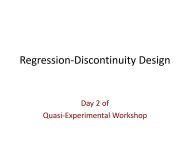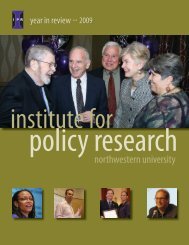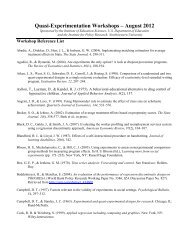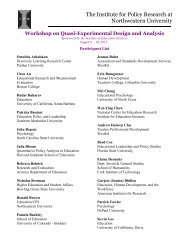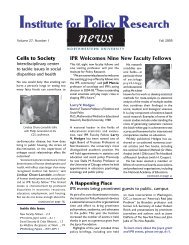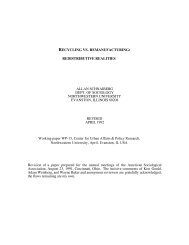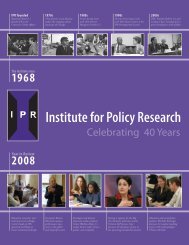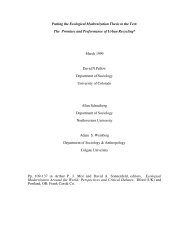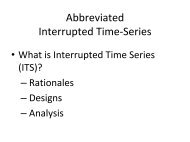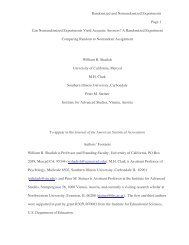pdf - Institute for Policy Research - Northwestern University
pdf - Institute for Policy Research - Northwestern University
pdf - Institute for Policy Research - Northwestern University
You also want an ePaper? Increase the reach of your titles
YUMPU automatically turns print PDFs into web optimized ePapers that Google loves.
J. Reblando P. Reese<br />
Quantitative Methods <strong>for</strong> <strong>Policy</strong> <strong>Research</strong><br />
MMost researchers and academics tend to stick with the research methods they<br />
know best, learned mainly in graduate school—even though those methods<br />
might not represent current best practices or the most appropriate method.<br />
This is one reason why IPR Faculty Fellow Larry V. Hedges, with the support<br />
of a group of distinguished interdisciplinary scholars, launched the Center <strong>for</strong><br />
Improving Methods <strong>for</strong> Quantitative <strong>Policy</strong> <strong>Research</strong>, or Q-Center, at the<br />
<strong>Institute</strong> <strong>for</strong> <strong>Policy</strong> <strong>Research</strong>. Hedges, who is Board of Trustees Professor of<br />
Statistics and Social <strong>Policy</strong>, co-directs the center with Thomas D. Cook, Joan<br />
and Sarepta Harrison Chair in Ethics and Justice. Q-Center faculty work on:<br />
• improving designs, analysis, and synthesis in policy research,<br />
• designing better research methods <strong>for</strong> education,<br />
• fostering a community of scholars, and<br />
• developing new data sources and methods of data collection.<br />
Larry Hedges,<br />
Co-chair<br />
8 Overview of Activities<br />
Methodology and <strong>Research</strong> Designs<br />
Economist Charles F. Manski continues<br />
his line of work on the difficulties<br />
of selecting the best policy with<br />
limited knowledge of policy impacts.<br />
Manski, Board of Trustees Professor in<br />
Economics, finished his <strong>for</strong>thcoming<br />
book Identification <strong>for</strong> Prediction and<br />
Decision (Harvard <strong>University</strong> Press)<br />
that exposits his new methodology <strong>for</strong><br />
analyzing empirical questions in the<br />
social sciences. He recommends that<br />
researchers first ask what can be learned<br />
from data alone and then ask what can<br />
be learned when data are combined with<br />
credible weak assumptions. Inferences<br />
predicated on weak assumptions, he<br />
argues, can achieve wide consensus, while<br />
ones that require strong assumptions<br />
almost inevitably are subject to sharp<br />
disagreements.<br />
Thomas D. Cook, Joan and Sarepta<br />
Harrison Chair in Ethics and Justice,<br />
conducted a review of the history of<br />
the regression discontinuity design<br />
(RDD) in psychology, statistics, and<br />
economics that will appear in the Journal<br />
of Econometrics. Donald T. Campbell, who<br />
invented the design in 1958, and a group<br />
of <strong>Northwestern</strong> <strong>University</strong> colleagues,<br />
including Cook, worked on RDD until<br />
the early 1980s when the design fell into<br />
disfavor. Cook speculates on why RDDs<br />
held such a low profile until the mid-<br />
1990s. Since then the design has widely<br />
caught on, particularly among younger<br />
econometricians and labor economists<br />
in both the United States and Europe.<br />
Cook suggests why this 50-year-old design,<br />
rarely used until the beginning of this<br />
century, has been reborn.<br />
Cook and IPR graduate research<br />
assistant Vivian Wong have published<br />
a paper reviewing whether regressiondiscontinuity<br />
studies reproduce the<br />
results of randomized experiments<br />
conducted on the same topic. They<br />
enumerate the general conditions<br />
necessary <strong>for</strong> a strong test of<br />
correspondence in results when an<br />
experiment is used to validate any nonexperimental<br />
method. They identify three<br />
past studies where regression discontinuity<br />
and experimental results with overlapping<br />
samples were explicitly contrasted. By<br />
criteria of both effect sizes and statistical<br />
significance patterns, they then show that<br />
each study produced similar results. This<br />
Thomas Cook,<br />
Co-chair<br />
Q-Center faculty<br />
conduct research<br />
relevant to the<br />
center’s mission of<br />
improving designs,<br />
data collection,<br />
analysis, and<br />
synthesis in social<br />
policy research.<br />
www.northwestern.edu/ipr 43



